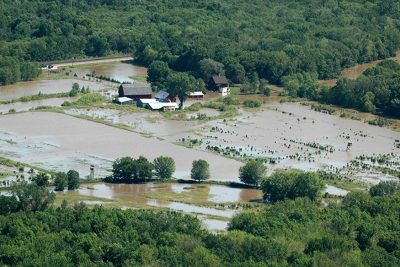Food Safety During a Power Outage, Flood or Other Disaster
Considerations for Connecticut Home Gardeners (This information applies to flooding occurring from rivers, lakes or stream overflows. Pooling water from a heavy rainfall is not considered “flooding” in this context.)
 Why be concerned about the safety of produce impacted by flooding?
Why be concerned about the safety of produce impacted by flooding?
Flood waters are likely to contain contaminants from septic systems, compost piles, lawns, roads, upstream agriculture operations or compromised municipal sewage systems. The contaminants can be direct health hazards to people and animals. Pathogenic (illness causing) microorganisms such as bacteria, viruses or parasites from raw manure, feces (sewage) or other sources can be present in flood water. Contamination from industrial chemicals, agricultural chemicals, oil, gas, heavy metals or other chemical contaminants could also pose a health hazard.
For this reason:
While it is difficult and the financial and emotional losses are likely to be great, all crops with edible portion that have come in contact with flood waters should be destroyed or discarded.
What you need to do:
- Discard/destroy all crops that have edible portions that have come in contact with flood water. This includes leafy greens, berries, tomatoes, squashes—everything that has come in contact with the flood water. While some sources will tell you that root crops can be cleaned to address the problem, this may not be accurate. It is best not to eat root crops that are under flood waters. Even cantaloupe and other hard shelled produce that is under flood waters must be considered unsafe to eat.
Produce from areas that were flooded without the edible part of the plant coming in contact with flood water (such as sweet corn, staked tomatoes) and crops in which the edible portion develops after flood waters recede are not automatically considered unsafe, but should be evaluated for food safety risk. You will need to consider the following before making a decision about eating them:
- Is the edible part of the plan developing or present? How far above the flood water is it?
- Is there any evidence that floodwater splashed up onto the edible portion of the crop?
- Is there any risk from cross-contamination from flood waters—by clothing, footwear, hands or equipment contaminated by flood waters?
- Prevent cross-contamination and protect yourself from contamination. If your garden is in near to a flooded area but has not come in contact with flood water, it is best to prevent cross contamination by keeping gardening implements and equipment away from the flooded area.
Take precautions to prevent cross-contamination. When using wagons, tractors, wheel barrels or similar equipment in the garden, do not drive through flood-contaminated areas into non-contaminated areas. Do not use garden implements in a non-contaminated garden after being contaminated with flood water without cleaning and sanitizing them first.
Wear protective clothing such as rubber boots and rubber gloves when working in gardens that were flooded. Protective clothing should be discarded or thoroughly cleaned and disinfected after use.
Cleaning and Sanitizing Garden Implements
- Remove loose, visible soil.
- Wash with detergent and water.
- Rinse with water.
- Sanitize with a 100 ppm solution of chlorine bleach (1 tablespoon of bleach to 1 gallon of water).
Check your well
If the well head is under flood waters, there is a potential for contamination of the well water. You must have the well water tested before using.
Can I just cook it?
Some might wonder why you just can’t cook contaminated fruits and vegetables to make them safe. While it is possible that pathogens could be eliminated by cooking, it depends in part on the extent of contamination. Normal cooking may not make a highly contaminated food safe for eating. And then there is the issue of bringing contaminated food into the kitchen and cross-contaminating cooking surfaces, utensils or ready to eat foods. Finally, if the flood waters contain certain chemicals, heavy metals or other toxins, it may not be possible to wash or cook away the contamination.
Can I preserve the produce from the garden?
Canning produce that has been affected by flood waters is not recommended. Not only is there the possibility of cross-contamination during preparation, the quality of the produce is likely to be low and these products are at higher risk for chemical and physical contaminants.
What about replanting?
Research suggests that it is best not to replant flooded areas for 60 days (as long as the soil has had enough time to dry out).